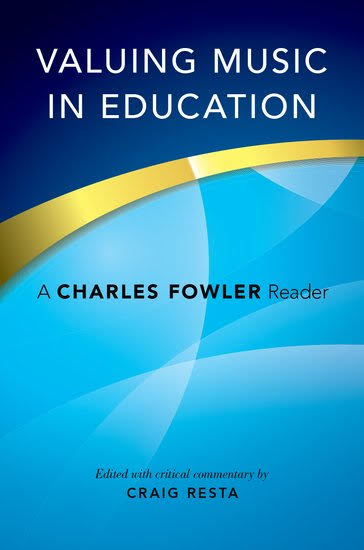Review by Martina Vasil
Assistant Professor of Music Education and Director of the Modern Band, Orff Schulwerk and Dalcroze Summer Institute, University of Kentucky, USA
Valuing Music in Education: A Charles Fowler Reader was published in 2017 through Oxford University Press and was edited by Dr. Craig Resta. The book is a collection of 50 essays (displayed as chapters) written by arts education advocate, Charles Fowler. Resta handpicked these essays out of a total collection of 164 essays Fowler had written over a 15-year period as the education editor of the classical music magazine, Musical America. The Preface and Introduction of the book set up the historical context of Fowler’s writings, then Resta organised the 50 essays into five sections: (1) Music Pedagogy and Schooling; (2) Advocacy and Arts Education Policy; (3) Arts, Culture, and Community; (4) Music Education and Professional Reform; and (5) Diversity and Pluralism in Art Education. Prior to each essay, Resta provided commentary that set the historical context for the writing of the essay as well as critical commentary as it pertains to music education today. While the topics of Fowler’s essays were quite diverse across his writing career, a central theme was this: arts education is integral to American culture.
Preface and Introduction
In the Preface, Resta justified his interest in compiling the work of Charles Fowler and explained his process for choosing the articles for inclusion in this edited volume. Resta posited that Fowler’s work continues to resonate with issues the field of music education faces today. In the Introduction, Resta provided a short biography of Fowler, starting with his education and teaching career, then highlighting important publications that marked points in the development of Fowler’s philosophical thinking about music education, and finally describing Fowler’s editorial work. Resta stated the purpose of the edited book: “to examine and reveal Charles Fowler’s works that illustrate how he advocated for and valued music education, all the while echoing and pushing forward other important voices in the field” (p. 4). The release of this book on the 50th anniversary of the Tanglewood Symposium was timely. As Resta stated—Fowler’s writing continues to resonate with issues the field of music education faces today.
Section 1: Music Pedagogy and Schooling
Section 1 is titled, Music Pedagogy and Schooling. This section of 12 essays covers a variety of topics. Resta organised the essays chronologically from August 1974–November 1988, but I summarise the content of these essays below according to topical themes: assessment, advocacy efforts, and arts education.
Essays related to assessment included: a discussion of the poor results from the National Assessment of Educational Progress (1971–72) and the issues with standardised testing in music; the improved results of the second application of the National Assessment of Educational Progress (1978–79) and what that meant; and the problem with evaluating and assessing the arts according to a purely behavioral objectives. Fowler noted that while assessment can lead to revisions and improvements in content, there is a danger when one starts teaching only to the test, as the aesthetic and subjectivity of the arts is then lost. On the other hand, it is important to hold music teachers accountable for student learning—this is best done through teacher-created tests that capture the essence of arts education and will look different than evaluations in language arts and math. Evaluation can also be used by arts educators as a tool to ensure decision makers are aware of the benefits of arts education and for us to keep our place in schools.
Advocacy-related essays encompassed: a review of a book about the value of arts education in schools; the effectiveness of advocacy efforts from the Music Educators National Conference (MENC, now the National Association for Music Education); and the discussions about music education advocacy and purpose that emerged from “The Future of Music Education in America” conference held in 1983 at the Eastman School of Music. Fowler concluded that music education needs to broaden its content, connect music back to real life, and improve in quality in K–12 schools and higher education.
Arts education essays comprised of: the pros and cons of high schools that specialise in arts education; a review of Howard Gardner’s 1983 publication, Frames of Mind: The Theory of Multiple Intelligences (and how it challenges the entire system of an education based on language arts and math by arguing for an educational system that supports all intelligences); Fowler’s critique of a lack of creativity in music education which damages the credibility and importance of music in the curriculum; a discussion of what academic means in the arts through examining a series of treatises (The Green Book) released by the College Entrance Examination Board (1983–84) designed to help secondary school teachers prepare students for college; and a reflection on a special segment of the MENC conference celebrating the 150th anniversary of music education in U.S. schools. Overall, Fowler believed that while music teachers claim to develop creativity in students, they do nothing of the sort; instead of teaching students how to capture meaning and expression with music, students are taught to re-create what has been done as if music is already a finished product. Music education tends to value knowledge and skills over historical and social context. Fowler argued that creating music makes it relevant, meaningful and valued. He also suggested balancing the academic and experiential aspects of music education.
Section II: Advocacy and Arts Education Policy
Section II is titled, Advocacy and Arts Education Policy. This section of 11 essays covers largely meetings and reports related to arts education policy, organised chronologically from February 1975–March 1989. These include: a 1975 meeting between state-level arts education leaders; a meeting where the Arts in Education Study project was discussed, a study of the educational programs funded by National Endowment for the Arts (NEA); a 1977 report on the state of the arts in education; a review of data on student music enrollment; a large collection of funded projects from 1978–79 to provide a snapshot of funding for arts programs; a report that evaluated how arts funding could be improved at the federal level; congressional reports affecting arts education; “The Arts and Public Policy in the United States” assembly report (a meeting of leaders in the arts); state regulations that have high school requirements of arts classes for high school graduation; and a major report on the state of arts education in the US completed by the NEA.
Overall, this section had recurrent themes. Reports indicated a need for better arts education in the public schools; better outreach of arts programming to the public; and better communication between arts communications. Arts programs need to be integrative—siloing support and funds leads to the divisiveness and the arts need a united front. Arts education should be more inclusive, especially at the secondary level. Federal and state reports said the same thing over and over; the arts should have a central role in the curriculum; it should be a broad education that is inclusive of all students; programming should be integrative of all arts forms. How can we achieve this? Fowler suggested focusing on arts education rather than purely performance and entertainment; improve communication between arts organisations; and advocate for the arts in the political realm to get state support of curricular requirements at the secondary level.
Section III Arts, Culture, and Community
Section III is titled, Arts, Culture, and Community. Here, Fowler described model community arts advocacy programs and groups across 8 essays. Resta organised these chronologically from January 1976–July 1988. Programs included were the Smithsonian Museum’s Festival of American Folklife, symphony orchestra and opera outreach, and programs provided by public educational institutions. Fowler also highlighted senior citizen symphonies, community music groups, and settlement schools and how they provide programming for local communities. Overall, the theme for this section is collaboration—educative communities and societies can help support the arts. The section ends with a probing essay in which Fowler questioned the repertoire, pedagogy, and curriculum included in arts education programs in schools at the time—questions that are still very much relevant today as they were in 1988.
Section IV: Music Education and Professional Reform
Section IV is titled, Music Education and Professional Reform. This collection of 10 essays from April 1976–July 1987 includes summaries of reports on the status of arts education in the United states, critiques of higher education, a review of a MENC conference and the issues facing MENC in the 70s, a revisiting of the Tanglewood Symposium, and a few essays that provide a vision for arts education moving forward. This section had prominent themes of the need for music education to be more broad, inclusive, diverse, academic, creativity-based, and collaborative. Fowler scathingly critiqued higher education, particularly composers in the institution and their lack of commercial involvement (and refusal to be a part of it). Overall, Fowler made the strong point that education reform is dependent on teacher training.
Section V: Diversity and Pluralism in Arts Education
The last section is titled, Diversity and Pluralism in Arts Education, including articles from June 1976–February 1983. This collection of 9 essays address a variety of issues facing teachers in the 70s and 80s: sex and age bias, controversial repertoire, diversifying repertoire, and how to best reach gifted students and special learners. Successful programs were highlighted in Fowler’s essays, such as a magnet school for gifted students in the arts, the Kennedy Center’s diversified programming to reach African American audiences, and successful festivals geared toward special learners. Further, Fowler pointed to the self-imposed image of the “starving artist” and questioned why arts education cannot include the popular and commercial and be purposeful and useful in society. He also critiqued how music education continues to emphasis specialist music education programs instead of providing curriculum open to all students. He reinforced the need to have both broad and specialised courses in arts education.
Conclusion
This book was written for practitioners, parents, music teacher educators, and anyone who is an arts education advocate. Resta hoped that this book would be a useful contribution to music education scholarship and aid in promoting the role of music in education nationwide, and I think that he has accomplished that goal. The book has many strengths. First, it is logically ordered, and the essays that Fowler wrote are short and clear. Second, the book is thought-provoking. The most interesting aspect of reading these essays was the pervasiveness of some issues in music education and the variety of solutions offered in detail for the reader to consider for implementation. In reading this, I often thought, “why haven’t these recommendations been followed?”. It seems that so much has been written about what ought to be promoted and happening, yet those in music education and arts advocacy continue to make the same mistakes. This book underlines the importance of knowing your history. What has been done before? What has been learned? What can we learn from the past and apply to our present and future? This book would be a great addition to any Foundations of Music Education class.
While I am largely a fan of this book, there are a few tweaks that I would suggest to the editor. First, while it is clear that the essays are presented chronologically within sections, I wonder if they could have been organised thematically, such as in section 1 (e.g., placing all essays related to assessment and testing together). I found myself wishing that similar articles would have been back to back as I progressed through the book. For example, I thought that “Educational Reform: Ferment in the Arts” (in Section IV) would fit better within the prior section on policy. Second, at times the content got a bit repetitive; mostly in Section II where Fowler summarises many reports on the state of arts education in the United States. However, perhaps this was the fault of how I approached the book, as I consumed it over two days. For the prospective reader, I do not recommend this volume for a single session, but rather as a resource to turn to when researching certain topics or studying various aspects of music education in a foundations class. Third, although the front matter that Resta provided at the start of each chapter was perfect for setting the context, I think a summary commentary by Resta at the end of each section highlighting themes and important points would help the reader digest the large amount of information in this edited volume.
Overall, this is a valuable book that both informs and challenges readers. I conclude this review with a challenge Resta posited to his readership. For those who want to make music a central part of the curriculum: “what will your role be in promoting this noble goal?” (p. 9).
About the reviewer
Martina Vasil, PhD, is assistant professor of music education and director of the Modern Band, Orff Schulwerk, and Dalcroze Summer Institute at the University of Kentucky. She teaches collegiate courses in general music, popular music education, and qualitative research and teaches children preK–6 at Lexington Montessori School. She is Orff III, Dalcroze II, and World Music Drumming I certified. Martina’s research centres on popular music education, curricular change, and Orff Schulwerk. She has been published in the International Journal of Music Education, the Journal of Music Teacher Education, UPDATE: Applications of Research in Music Education, and The Orff Echo.
Available to buy
Physical book: available from all good book retailers including Book Depository - paper book, freight free.
Ebook: go to Books2Read which will provide you with a range of suitable links for an e-version of this book













